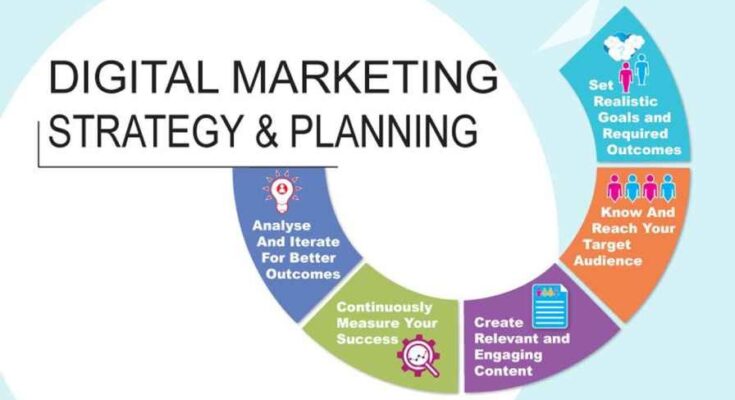Creating a digital marketing strategy from scratch may seem daunting, but it’s essential for small businesses aiming to grow in today’s competitive market. A well-structured digital marketing plan helps you connect with your audience, build brand awareness, and drive sales. Whether you’re a small business owner or a marketing manager, this guide will provide you with all the tools and insights you need to create a robust digital marketing strategy that delivers results.
Understanding Your Business and Target Audience
Define Your Unique Selling Proposition (USP)
Your USP is what sets your business apart from the competition. It’s the unique benefit that your products or services offer to your customers. Identifying your USP is the first step in creating a successful digital marketing strategy. Think about what makes your business special. Is it the quality of your products, exceptional customer service, or unique features? Once you’ve identified your USP, ensure that it’s clearly communicated across all your marketing channels.
A clear USP not only attracts potential customers but also helps retain existing ones. Make sure your USP is relevant to your target audience’s needs and preferences. Conduct surveys or focus groups to gather feedback and refine your USP based on real customer insights. This will make your digital marketing efforts more effective and focused.
Analyze Your Target Audience
Understanding your target audience is crucial for creating a digital marketing strategy that resonates with them. Start by analyzing your existing customer base. Look at demographics such as age, gender, location, and income level. Additionally, consider psychographics like interests, behaviors, and purchasing habits.
Tools like Google Analytics, social media insights, and customer surveys can provide valuable data. Use this information to create detailed buyer personas – fictional representations of your ideal customers. These personas will guide your content creation, messaging, and channel selection, ensuring that your marketing efforts are targeted and effective.
Setting Measurable Goals
The Importance of SMART Goals
Setting clear, measurable goals is essential for any digital marketing strategy. SMART goals – Specific, Measurable, Achievable, Relevant, and Time-bound – provide a framework that ensures your objectives are realistic and trackable. For example, instead of setting a vague goal like “increase website traffic,” a SMART goal would be “increase website traffic by 20% over the next three months.”
SMART goals help you stay focused and provide a benchmark for measuring success. They also make it easier to communicate your objectives to your team and stakeholders, ensuring everyone is aligned and working towards the same targets.
Examples of Digital Marketing Goals
For small businesses, digital marketing goals can vary widely depending on your specific needs and circumstances. Here are some examples of attainable goals:
- Increase email list sign-ups by 15% in the next quarter.
- Achieve a 10% conversion rate on a new landing page.
- Boost social media engagement by 25% within six months.
- Generate 50 new leads through a PPC campaign in the next month.
Setting and achieving these goals will not only improve your digital marketing efforts but also contribute to the overall growth of your business.
Choosing the Right Digital Channels
Overview of Digital Marketing Channels
There’s a multitude of digital marketing channels available, each with its own strengths and weaknesses. Some of the most popular channels include social media, email marketing, SEO (Search Engine Optimization), PPC (Pay-Per-Click) advertising, and content marketing. To choose the right channels for your business, consider your target audience’s preferences and behaviors.
Social media platforms like Facebook, Instagram, and LinkedIn offer opportunities for engagement and brand building. Email marketing is excellent for nurturing leads and maintaining customer relationships. SEO improves your website’s visibility on search engines, attracting organic traffic. PPC allows for targeted advertising with measurable results. Content marketing involves creating valuable content to attract and engage your audience.
Tips on Selecting Channels that Align with Your Goals
Selecting the right channels requires a strategic approach. Start by analyzing where your target audience spends their time online. Use tools like Google Analytics, social media insights, and competitor analysis to gather data. Next, consider your goals and budget. Some channels, like SEO and content marketing, require a long-term investment, while others, like PPC, can deliver immediate results but may require a higher budget.
Finally, test different channels and measure their performance. Track key metrics such as engagement, conversion rates, and ROI. This will help you identify the most effective channels for your business and allocate your resources accordingly.
Crafting Your Message
Importance of Consistent Branding and Messaging
Consistency is key when it comes to branding and messaging. Your brand voice should be recognizable across all digital channels, creating a cohesive experience for your audience. This includes visual elements like logos and color schemes, as well as the tone and style of your written content.
Create a brand style guide to ensure consistency. This should include guidelines for logo usage, color palettes, typography, and tone of voice. Share this guide with your team and any external partners to maintain a unified brand identity.
Tips on Creating Compelling Content
Compelling content is essential for engaging your audience and driving conversions. Start by understanding your audience’s needs and preferences. What are their pain points? What type of content do they find valuable? Use this information to create content that addresses their concerns and provides solutions.
Use a mix of content formats, including blog posts, videos, infographics, and social media updates. This keeps your audience engaged and caters to different learning preferences. Additionally, ensure that your content is optimized for SEO, incorporating relevant keywords naturally throughout the text. This will improve your search engine rankings and attract organic traffic.
Implementing and Evaluating Your Strategy
Actionable Steps for Implementation
Implementing your digital marketing strategy requires careful planning and execution. Start by creating a detailed action plan that outlines each step, along with timelines and responsible parties. This ensures that everyone knows what needs to be done and when.
Use project management tools like Trello or Asana to track progress and collaborate with your team. Regularly review your plan and make adjustments as needed. Stay flexible and be prepared to pivot if something isn’t working as expected.
Metrics to Track and Evaluate Success
Tracking the right metrics is essential for evaluating the success of your digital marketing efforts. Some key metrics to monitor include website traffic, conversion rates, click-through rates, and ROI. Use tools like Google Analytics, social media insights, and email marketing platforms to gather data.
Regularly review your metrics and compare them to your SMART goals. Identify what’s working and what isn’t, and make data-driven decisions to optimize your strategy. This continuous evaluation and adjustment will help you achieve better results over time.
Adjusting and Improving Your Strategy
Importance of Flexibility and Continuous Improvement
Digital marketing is an ever-evolving field, and staying flexible is crucial for success. Be prepared to adapt your strategy based on performance data, industry trends, and changes in your target audience’s behavior. Continuous improvement is key to staying competitive and achieving long-term success.
Tips on How to Adjust Your Strategy
When adjusting your strategy, start by analyzing the data. Identify areas where you’re meeting or exceeding your goals, as well as those where you’re falling short. Use this information to make informed decisions about where to allocate your resources and efforts.
Experiment with different tactics and channels, and measure their impact. Regularly update your goals and action plan to reflect new insights and opportunities. This iterative approach will help you stay agile and responsive to changes in the digital landscape.
Conclusion
Creating a digital marketing strategy from scratch may seem challenging, but with the right approach and tools, it’s entirely achievable. By understanding your business and target audience, setting measurable goals, choosing the right channels, and crafting compelling content, you can build a strategy that drives results.
Remember to implement your plan carefully, track your metrics, and stay flexible as you adjust and improve your strategy over time. With dedication and effort, you’ll be well on your way to digital marketing success.
If you’re ready to take the next step in building your digital marketing strategy, don’t hesitate to reach out for expert guidance. Whether you need help with content creation, SEO, or social media management, our team is here to support you every step of the way. Start today and transform your digital presence.



